Dynamic Search Ads (DSAs) are designed to automate ad creation and target a wider audience. This campaign type offers a game-changing solution, combining automation and customization to tackle modern marketing challenges. In this post, we dive into its basis, mechanisms, benefits, and strategies to transform your audience engagement.
What are Dynamic Search Ads?
Dynamic Search Ads (DSAs) are a type of Google Ads, specifically within the category of Search Ads. They are displayed alongside standard text ads in search engine results pages (SERPs) when a user’s search query matches the content on the advertiser’s website.
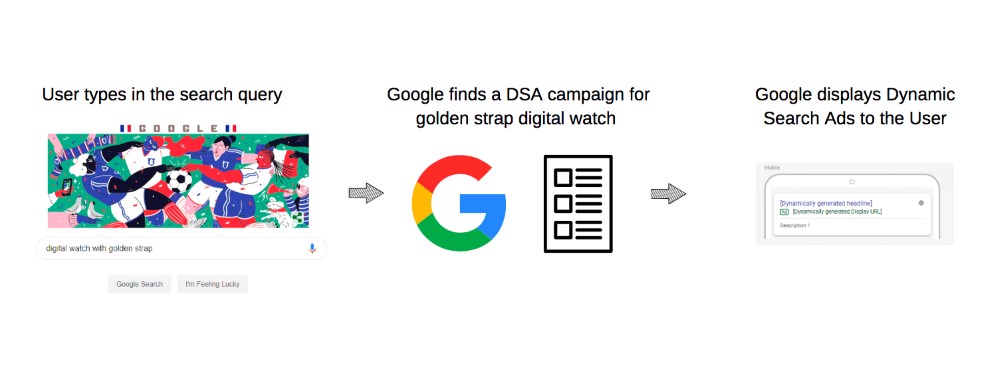
More specifically, DSAs scan the content of the website or specific landing pages to automatically craft ad copies that are relevant to users’ search queries. They can serve as an effective method for reaching keywords that might be overlooked by your conventional search campaigns. Here’s an example of Dynamic Search Ads:

How do Dynamic Search Ads work?
Dynamic Search Ads (DSAs) work by automatically generating ad headlines and selecting landing pages based on the content of your website. Here’s how:
- Website crawling: Google crawls across your website to index the content of your website. It identifies your site’s overall structure and discovers the main keywords.
- Query matching: The user makes a search on Google using a specific search query. Once the system has accumulated and analyzed your content, the DSA system compares a user’s search query on Google to the website’s indexed material as part of the query-matching process. It makes an effort to match your site’s structure and content with the user’s query.
- Ad generating: Based on the query and the content of your website, the DSAs system generates a dynamic headline and display URL for the ad. It aims to create an ad that closely matches what the user is looking for.
- Ad displaying: The generated ad is then displayed to the user alongside other search results.
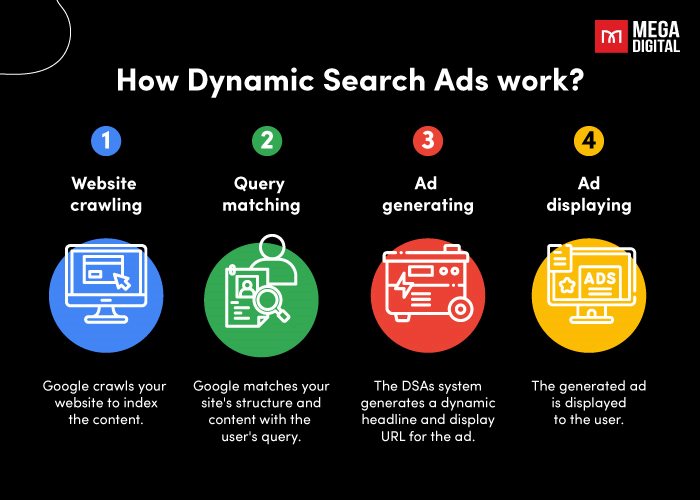
To put it simply, DSAs simplify the advertising process by automating keyword selection, ad creation, and targeting. They ensure that your ads are relevant to what people are searching for and lead to the most appropriate pages on your website.
Pros and Cons of Dynamic Search Ads
Benefits
DSA offers your business some significant benefits in terms of leveraging the advertising effectiveness of your campaigns.
1. Time and resources savings
Ad creation in Dynamic search ads is nowhere near being a complicated task. DSAs campaigns help you save tons of time and resources that would have otherwise been spent on continuous manual keyword research, ad creation, and optimization. This is especially beneficial for websites with a plethora of products or frequently changing inventory.
2. Broad coverage
DSAs campaigns can capture a wider range of search queries, including those you might not have thought of or included in traditional keyword-based campaigns. This comprehensive coverage captures additional traffic and expands your potential customer base.
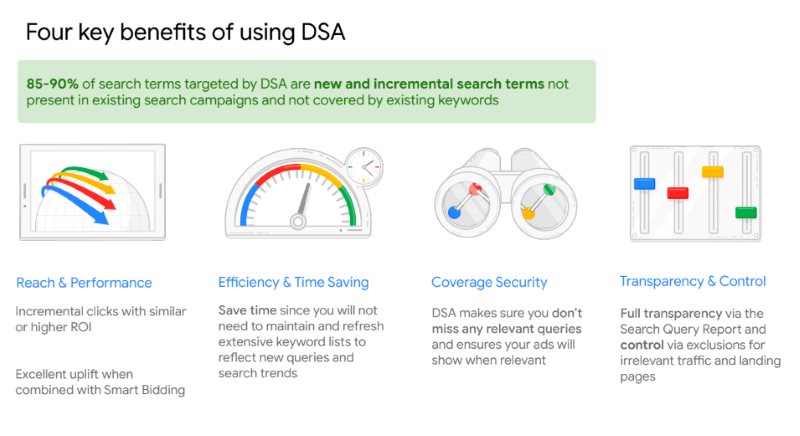
3. Real-time relevance
Ads generated by DSAs campaigns are dynamically created based on the user’s search query and your website’s content, enhancing user experience and increasing the likelihood of attracting qualified leads.
4. Reduced keyword management
DSAs campaigns eliminate the need for extensive keyword research and manual keyword updates, reducing the complexity of campaign management. This allows marketers to focus on other strategic aspects of their advertising campaign. See more details here.
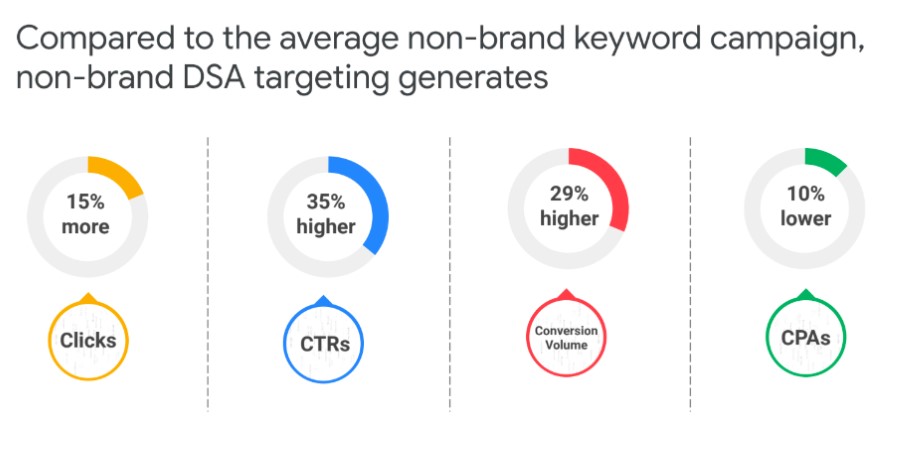
Downsides
While Dynamic Search Ads offer a range of benefits for digital advertising campaigns, it’s important to also recognize that there are also potential disadvantages that might be caused.
1. Limited control
Because Google generates the headlines and descriptions for DSAs campaigns dynamically, you have less influence over the ad’s content. The dynamically generated ads might not always stand toe to toe with the quality of manually crafted ads, which could impact the consistency while delivering your brand’s image.
2. Click quality
Due to the broad nature of DSAs campaigns, they might attract clicks from users who aren’t specifically interested in your offerings, leading to potentially lower conversion rates.
Who should use Dynamic Search Ads?
DSAs are a versatile tool that can benefit a wide range of businesses, regardless of their size or industry.
Small businesses looking to increase their online presence can leverage DSAs to efficiently target their audience.
Medium-sized companies can streamline their advertising efforts and stay ahead of the curve in the competitive digital landscape.
For large enterprises with extensive product catalogs, DSAs offer an automated way to showcase their offerings without the need for constant manual updates.
How to create a Dynamic Search Ads campaign?
Step 1: Set up a new campaign
- First, go to your Google Ads account and select “Create campaign”.
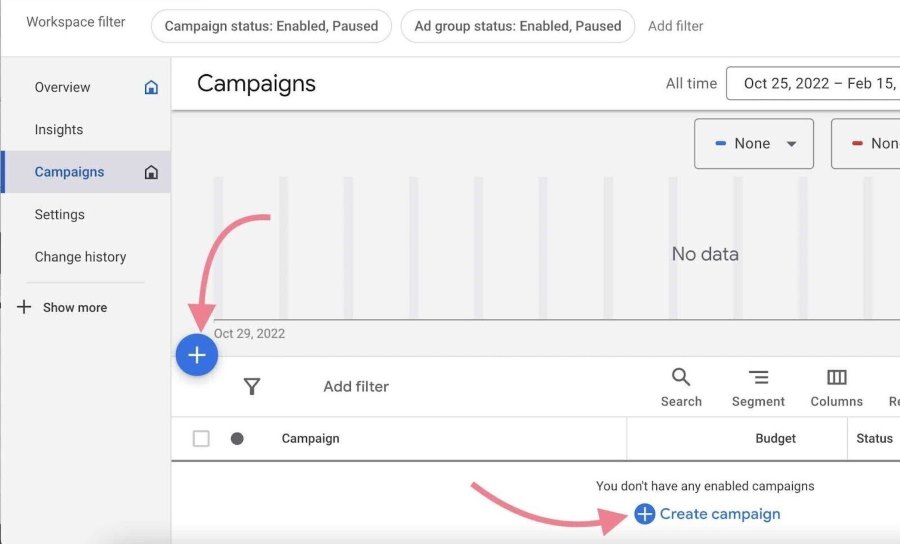
- Select your advertising goal. For Dynamic Search Ads, you might want to choose the “Sales” goal or “Leads” goal, depending on what you’re aiming to achieve.
- Next, choose “Search”.
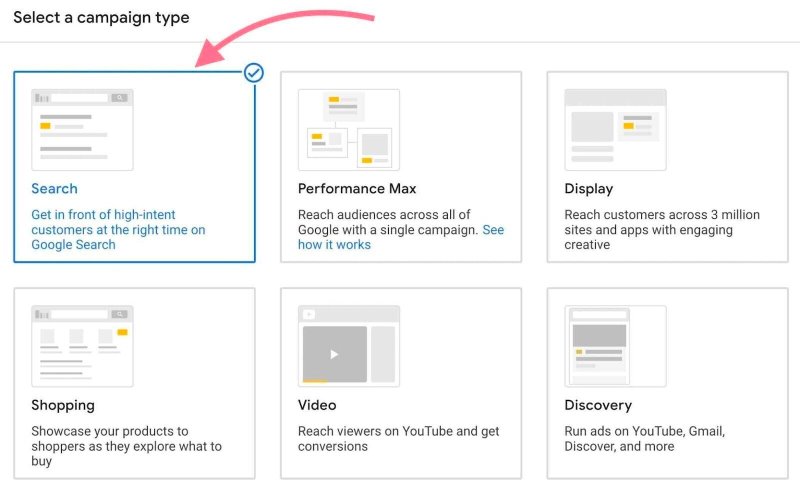
- Name your campaign and fill out all the fields to provide necessary information about your campaign: Networks, locations, languages, bidding, budget, start and end dates.
Step 2: Create a Dynamic ad group
- Select the Dynamic option as Ad group type.
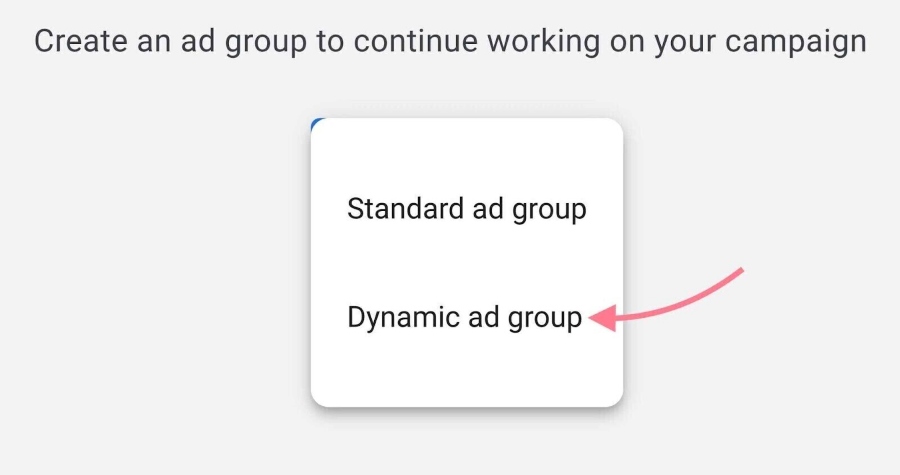
- Enter a name. Set your default maximum cost-per-click bid. Choose how you want your ads to rotate (optimize for clicks, optimize for conversions, etc.).
>>> Read more: Guide to Ad Rotation in Google Ads for Beginners
Next, you’ll set up Dynamic Ad Targets:
- Targeting Source: You can choose between “Website” and “Google’s index of your website”. Select the latter option.
- Website Domain: Enter the domain of your website.
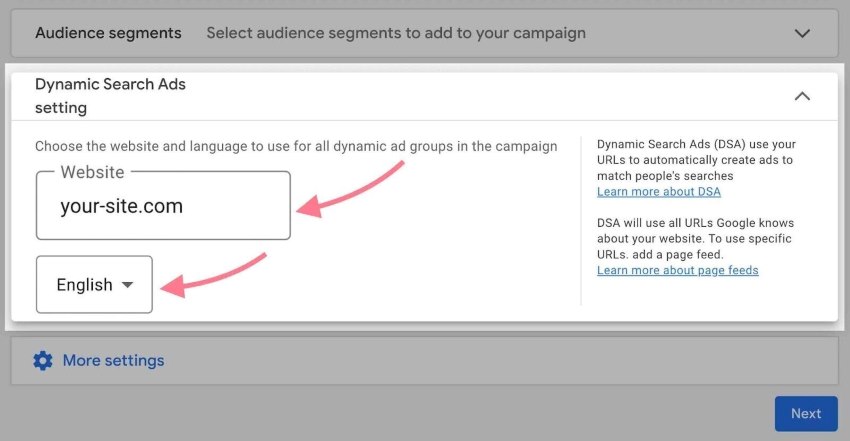
- Page Feed: You might need to set up a page feed. This is an XML feed that contains information about the URLs you want to advertise. Google provides guidelines on creating this feed.
- URL Options: You can choose whether to use all web pages or only specific pages based on certain criteria.
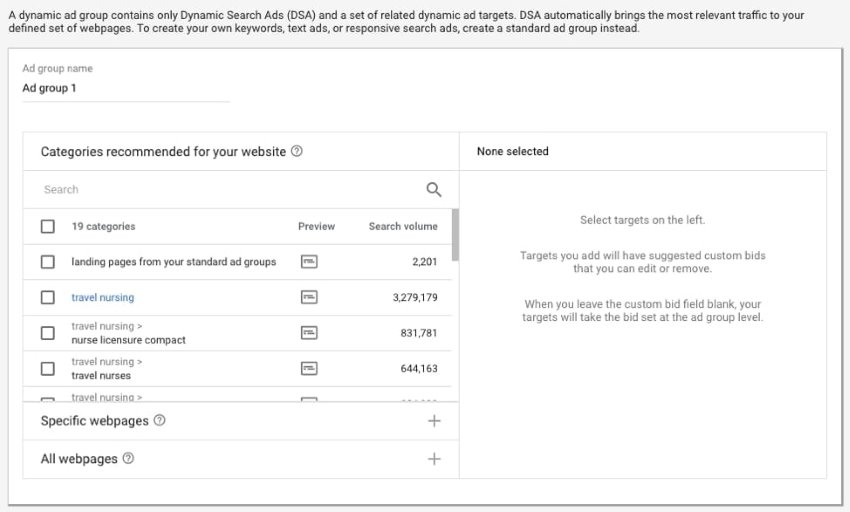
Step 3: Create ad copy
You’ll need to create dynamic ad templates. These templates will dynamically generate headlines and landing pages based on user searches. You can create multiple templates to test what works best.
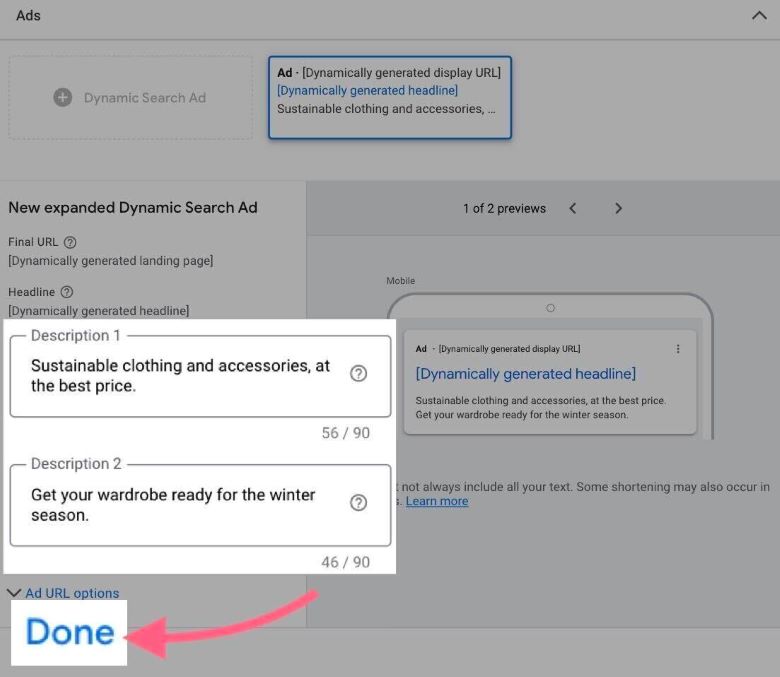
Step 4: Review and launch
Review all your campaign settings and ad group settings. Make sure everything is correct before launching the campaign.
DSAs Best practices for advertisers
Optimizing DSAs involves a combination of strategic planning and continuous monitoring and adjustments. Here’s a step-by-step guide to help you optimize your dynamic search ads effectively:
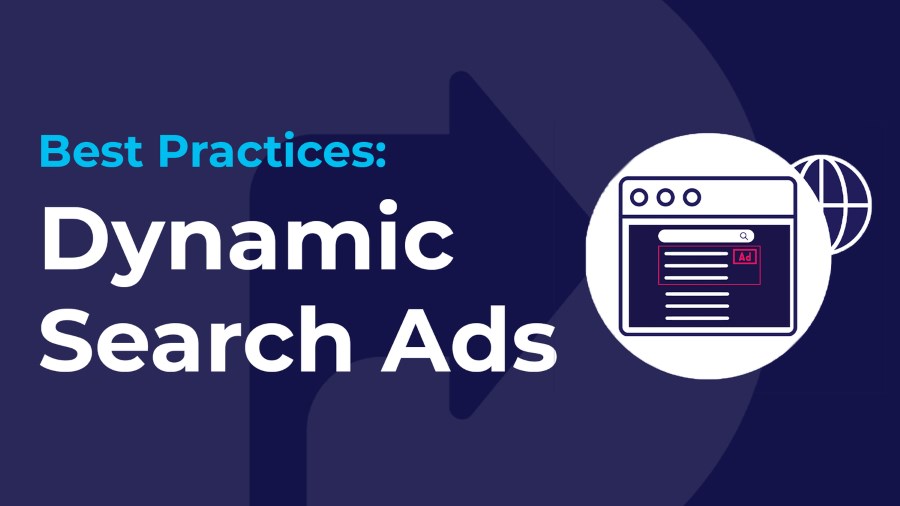
Understand your audience
Understand who your potential customers are, their preferences, needs, and behavior. Also, the audience size needs to be large enough to get substantial impressions. The exposure from serving an impression or obtaining a click will be valuable even if the individuals on this list do not convert.
Set a clear keyword strategy
A precise keyword strategy is essential for Google DSAs campaigns, ensuring visibility and alignment with user intent.
What to do:
- Check your search term report, sorted by impressions to focus on the largest volume keywords first.
- Use a combination of broad, phrase, and exact match negative keywords to refine the audience and prevent wasting ad spend.
>> To set up negative keywords in Google Ads, navigate to the keywords and targeting options, then edit negative keywords.
- Select particular pages to be excluded from being crawled, assuring no content from those pages will be matched to relevant search queries.
>> To set up exclusions, go into the platform, enter the Dynamic Ad Targets section, choose the campaign, and set the exclusion rules.
Optimize ad copy
Optimizing ad copy in Google DSAs can secure ad relevance, higher click-through rates, and cost-efficiency.
What to do:
- Write engaging ad copy: Craft compelling headlines and descriptions that highlight the value of your products or services.
- Test different variations: Experiment with different ad copy variations to identify which ones relate best to your audience.
Use value-based bidding
With offline conversions as the campaign goal, value-based bidding is ideally used to enable machine learning to optimize for the most crucial leads based on back-end data.
>>> Read more: 8 Google Ads Automated Bidding Strategies & Their Hidden Secrets
Monitor performance and optimize continuously
- Monitor your campaigns regularly to identify trends, areas of improvement, and potential issues.
- Based on performance data, adjust bids and budgets to maximize Google Ads ROI.
- Analyze search terms triggering your DSAs and add high-performing terms as regular keywords in targeted campaigns
Continuously monitor your dynamic search ad campaigns, adapt to changing trends, and refine your strategies based on performance data.
A case study: Applying Google Dynamic Search Ads
Client background
Our client, a prominent player in the fashion industry, Juanandidy, partnered with Mega Digital to address their online advertising challenges. They were seeking a solution to enhance their online presence, attract potential customers, and ultimately boost their fashion sales.

Challenge
Before engaging with Mega Digital’s services, our client faced several key challenges:
- Limited Online Visibility: The client struggled to stand out in the highly competitive online fashion market, making it difficult for potential customers to discover their brand.
- Inefficient Ad Spend: They felt that their previous online advertising efforts were not delivering the desired results, leading to inefficient allocation of their marketing budget.
- Lack of Targeted Marketing: The client needed a more effective way to target their ideal audience and tailor their advertising strategies to meet customer preferences.
Solution
Mega Digital leveraged Google Dynamic Ads to create a tailored advertising campaign for our fashion industry client. Our strategy included:
- Keyword Optimization: We conducted thorough keyword research to identify high-impact keywords relevant to the fashion industry, ensuring our client’s ads appeared in relevant searches.
- Ad Campaign Customization: We designed compelling and visually appealing ad creatives that showcased our client’s fashion products and brand identity.
- Audience Targeting: We implemented audience targeting strategies to reach the most relevant and potential customers, increasing the chances of conversions.
- Continuous Optimization: We constantly monitored and adjusted the campaign to ensure optimal performance and cost-efficiency.
Results
After partnering with Mega Digital and implementing our Google Ads strategy, our fashion industry client achieved remarkable results. Their brand gained significant online visibility, with an impressive increase in website traffic of 80%, and brand recognition.
But the real standout achievement was their return on investment (ROI), which saw an incredible threefold increase of 300%. This means their advertising budget was allocated more efficiently, leading to substantially higher sales and revenue.
Final words
In the ever-evolving landscape of digital advertising, Dynamic Search Ads stand out as an efficient way to harness the power of automation. By dynamically tailoring ad headlines and landing pages to user search queries, DSAs streamline campaign management while expanding your reach.









